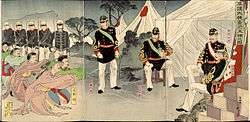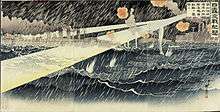Toshihide Migita
In this Japanese name, the family name is Migita.
Toshihide Migita (右田年英 Migita Toshihide, 1862 - 1925), also known as Oju Toshihide or Toshihide was a Japanese artist, creating work in traditional ukiyo-e prints and painting in the Western syle.[1]
Migata was apprenticed to Tsukioka Yoshitoshi. He also studied with Kinisawa Shimburō (1847–1877), who was an artist who had trained in Britain.[1]

“Illustration of Chinese Generals from Pyongyang Captured Alive” by Migita Toshihide, October 1894. Collection of Museum of Fine Arts, Boston

Japanese destroyers attacking enemy (Russian) ships at Port Arthur — ukiyo-e woodblock print by Migita Toshihide, March 1904.
Starting in 1877, his work was published in newspapers and magazines. His portraits of Kabuki actors were well known.[1]
His war prints (戦争絵 sensō-e), in triptych format are considered to be important historical documents. This work documents Japan's participation in the First Sino-Japanese War and the Russo-Japanese War.[1]
See also
| Wikimedia Commons has media related to Migita Toshihide. |
Notes
References
- Nussbaum, Louis Frédéric and Käthe Roth. (2005). Japan Encyclopedia. Cambridge: Harvard University Press. ISBN 978-0-674-01753-5; OCLC 48943301
This article is issued from Wikipedia - version of the 9/9/2016. The text is available under the Creative Commons Attribution/Share Alike but additional terms may apply for the media files.
